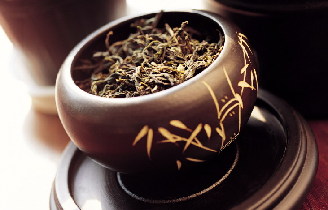
Of the three major beverages of the world -- tea, coffee and cocoa -- tea is consumed by the largest number of people.
Tea, the most popular beverage for the Chinese, is one of China's specialties and traditional exports. According to historical data, China began to grow tea about two thousand years ago during the period of the Warring States (475-221BC).
It is universally acknowledged that China is the original tea-growing area, as well as the first country to grow, produce and drink tea.
In the Song (960-1279) and Yuan (1271-1368) Dynasties a popular custom was tea appraising. Over the long history of drinking tea, a special and simple Chinese tea culture came into being. Drinking tea was not only for quenching thirst or for enjoyment, but also for the promotion of friendship and mutual understanding. Folk customs of drinking tea reflected the ancient Chinese people's great interest in tea culture.
People often used tea as a betrothal gift; for it could not be "transplanted." After accepting tea as a betrothal gift, a girl could not capriciously change her decision to marry her fiancé.
Entertainment of guests to tea is the most fundamental social behavior in the Chinese people's contacts with each other. When a guest comes, the Chinese will offer him or her a cup of tea to express friendship.
China is the home country of tea. Before the Tang Dynasty (618-907), Chinese tea was exported by land and sea, first to Japan and Korea, then to India and Central Asia and, in the Ming (1368-1644) and Qing (1644-1911) Dynasties, to the Arabian Peninsula. In the early period of the 17th century, Chinese tea was exported to Europe, where the upper class adopted the fashion of drinking tea. Chinese tea, like Chinese silk and china, is an outstanding contribution to the world's material and spiritual civilization.
China is the homeland of tea. It is believed that China has tea-shrubs as early as five to six thousand years ago, and human cultivation of tea plants dates back two thousand years. Tea from China, along with her silk and porcelain, began to be known over the world more than a thousand years ago and has since always been an important Chinese export. At present more than forty countries in the world grow tea, with Asian countries producing 90% of the world's total output. All tea trees in other countries have their origin directly or indirectly in China. The word for tealeaves or tea as a drink in many countries is derivatives from the Chinese character "cha." The Russians call it "cha'i", which sounds like "chaye" (tea leaves) as it is pronounced in northern China, and the English word "tea" sounds similar to the pronunciation of its counterpart in Xiamen (Amoy). The Japanese character for tea is written exactly the same as it is in Chinese, though pronounced with a slight difference. The habit of tea drinking spread to Japan in the 6th century, but it was not introduced to Europe and America till the 17th and 18th centuries. Now the number of tea drinkers in the world is legion and is still on the increase.
